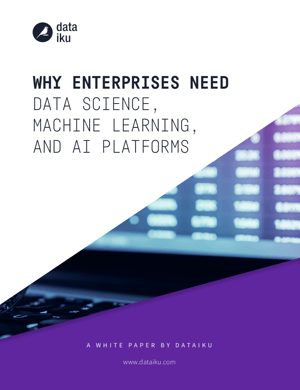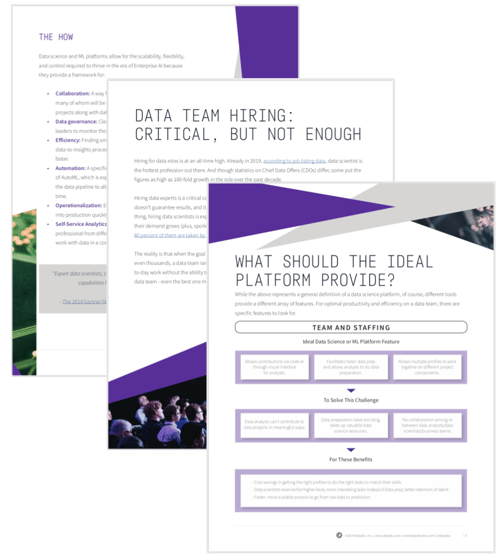How & Why They're Critical to Today's Enterprise
 Enterprise AI is at peak hype, yet AI has yet to fundamentally change most businesses. For the most part, those that have been successful have democratized the use of data throughout the organization. But how can everyone else catch up?
Enterprise AI is at peak hype, yet AI has yet to fundamentally change most businesses. For the most part, those that have been successful have democratized the use of data throughout the organization. But how can everyone else catch up?
Enter: data science, machine learning, and AI platforms. This white paper talks about:
1. An overview of the state of the market today.
2. Why companies need data platforms.
3. Why good hiring and open source alone can't fill the gap.
4. Key features to look for in data platform technology.

Florian is the Chief Executive Officer of Dataiku, the platform democratizing access to data science and enabling enterprises to build their own path to AI. The company has raised $145M to date and has spurred this journey to Enterprise AI for hundreds of large enterprise customers around the world.
Florian started working in the startup world at age 20 and hasn't stopped since. He’s fond of creative writing (see AI Musings for a small taste), playing with real and artificial languages, as well as any board or screen games where he still has a chance to beat his kids. He’s also committed to Paris, a city where he was born, raised, loved and lives; Florian invests in and helps companies and tech founders as a small contribution to the growing Paris tech ecosystem.
In their most basic form, data science, machine learning (ML), and AI platforms are tools to enable Enterprise AI by allowing people within the organization to:
Ultimately, data science, ML, and AI platforms are about time. That means time savings in all parts of the processes (from connecting to data to building ML models to deployment), of course. But it’s also about easing the burden of getting started in AI and allowing businesses to dive in and get started now - not waiting for years until technologies sure up and the world of AI becomes more clear (because spoiler alert: that may never happen).
Getting started on the AI journey is intimidating, but this white paper will break down how data science and ML platforms can ease that burden and provide a framework that allow companies to learn as they go.

There’s no question that open source technologies in data science and machine learning are state-of-the-art and that organizations have to adopt them to be dynamic and future-minded. In fact, the bleeding edge of data science algorithms and architecture is only about six months ahead of what is being open sourced, whether directly by these companies or via original development or reverse engineering.
In addition to being on the bleeding edge of technological developments, using open source makes it easier to hire and onboard a team. Not only are prospective data scientists interested in growing their skills with the technologies that will be the most widespread in the future, but also there is less of a learning curve if they can continue to work with tools they know and love instead of being forced to learn an entirely different (and usually less innovative) system.
It's important to remember, though, that keeping up with that rapid pace of change is difficult for enterprise-sized organizations. These latest innovations are usually highly technical, so without some sort of packaging or abstraction layers that make the innovations more accessible, it's very difficult to keep everybody in the organization on board and working together.
Data science and ML platforms have the advantage of being usable right out of the box so that teams can start analyzing data pretty much from day one. Choosing a data science and ML platform wisely (meaning one that is flexible and allows for the incorporation and continued use of open source) can allow the best of both worlds in the enterprise: cutting-edge open source technology and accessible, governable, control over data projects.
The reality is that in the age of AI, businesses of any size can’t afford to work without a data science, machine learning, or AI platform that enables and elevates not just their data science team, but the entire company to the highest level of data competence for the greatest possible impact.
What are you waiting for? Get the white paper to learn more.
.png?width=364&name=Why%20DS,%20ML,%20and%20AI%20Platforms%20-%20without%20cover%20(1).png)
Dataiku ©Copyright - 2021 / Privacy Policy